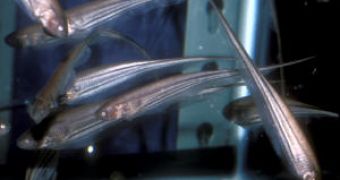From the most complex movements our bodies make, like complicated dance steps, to the simplest everyday acts, our brains perform complex commands.
It is hard for scientists to figure out how the brain does it, but a team at Johns Hopkins University has discovered some tantalizing mechanisms studying the undulating movements of a not so ordinary South American small nocturnal tropical fish, named "glass knifefish" (photo), as it's of an almost transparent white with a blade-shaped body.
The new findings could improve prosthetic limbs and rehabilitative techniques for people affected by stroke, cerebral palsy and other neurodegenerative diseases. "All animals, including humans, must continually make adjustments as they walk, run, fly or swim through the environment. These adjustments are based on feedback from thousands of sense organs all over the body, providing vision, touch, hearing and so on. Understanding how the brain processes this overwhelming amount of information is crucial if we want to help people overcome pathologies," said Noah Cowan, an assistant professor of mechanical engineering in Johns Hopkins' Whiting School of Engineering.
In fact, what's remarkable with the glass knifefish is its property of emitting weak electrical signals to "see" in the dark, the way bats use ultrasounds. "These fish are ideal both because we can easily monitor the sensing signals that their brains use and because the task we asked the fish to do -- swim forward and backward inside a small tube -- is very simple and straightforward," said Eric Fortune, assistant professor of psychological and brain sciences in the Krieger School of Arts and Sciences, also at Johns Hopkins.
The team checked the fish's ability to stay hidden by moving the tubes forward and backward at varying frequencies, fact that forced the fish to swim back and forth more and more rapidly in order to remain inside the tubes.
As the frequency got higher, the fish gradually became unable to keep up with the tubes' movement. "The team's detailed engineering analysis of the fish's adjustments under these conditions suggested that the animal's sensors and brains are "tuned" to consider Newton's laws of motion," Cowan said.
The fish's brain calculated velocity, so the fish could speed up or down so that it could keep in the moving tube. "The fish were able to accelerate, brake and reverse direction based on a cascade of adjustments made through their sensory and nervous systems, in the same way that a driver approaching a red light knows he has to apply the brakes ahead of time to avoid overshooting and ending up in the middle of a busy intersection," Fortune said.
"Your brain has to do this all the time when controlling movement because your body and limbs, like a car, have mass. This is true for large motions that require planning, such as driving a car, but also for unconscious control of all movements, such as reaching for a cup of coffee. Without this sort of predictive control, your hand would knock the cup off the table every time."
"That animals unconsciously know that they have mass seems obvious enough, but it took a complex analysis of a very specialized fish to demonstrate this," Fortune said. "With this basic knowledge, we hope one day to be able to 'tune' artificial systems, such as prosthetics, so that they don't have the jerky and rough movements that most robots have, which is critical for medical applications."
"As we move forward, we expect to discover other exciting aspects of brain function that suggest new ways to design sensory control systems for autonomous robots." said Cowan.

 14 DAY TRIAL //
14 DAY TRIAL //